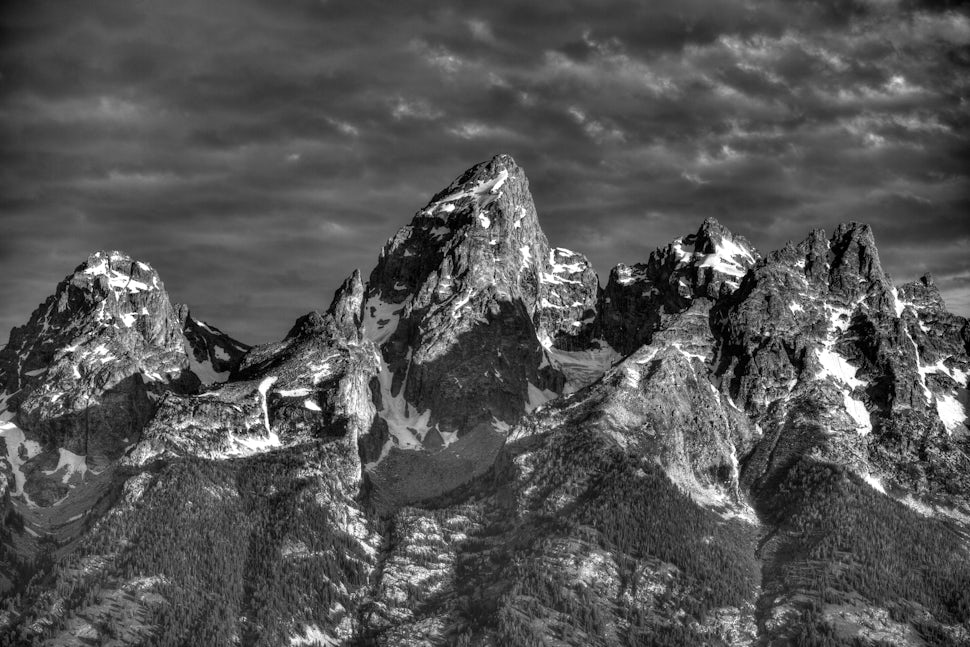Making a Case for Monochrome Landscape Photography
Why you should consider shooting your next adventure in black and white.

For the most part, it's always seemed a bit counterintuitive to me to shoot landscapes without color. The rich vibrance and diverse palette of available covers is, many times, the most-oft noticed element of a photograph (particularly landscapes), and therefore, becomes its focal point (pun intended).
However, I've been delightfully haunted by a lot of monochrome (black and white) landscapes I've both seen and shot lately. Like this (below), for example (from Mount Rainier National Park).

I could probably make a list of reasons as to why one might consider monochrome over color, though, when I started to ruminate on this topic a bit more, I felt compelled to couch this in more of a 'systems thinking' way, which, you may know, is a management discipline that concerns an understanding of a system by examining the linkages and interactions between the components that comprise the entirety of that defined system. So...let's think about a photograph, framing that photograph, and its overall composition as a 'system.' Just like a car has pistons, o-rings, an engine, dipstick, etc., or an ant colony has prescribed roles that serve the overall good of the order (I just wanted an excuse to talk about ant colonies because I love ants), so, too, are photographs comprised of a variety of elements. In that regard, color is just one aspect. If you were to describe the totality of a photograph's visual character and attributes therein, you might also talk about things like form (visual mass or shape), line (edges or linear definition), texture (surface coarseness), dominance (position, size, contrast), scale (apparent size as a visual element relates to its surroundings), diversity (a variety of visual patterns) and/or continuity (uninterrupted flow of form, line, color or textural pattern). As a result, if you think about the photo as a system where its sum is undoubtedly greater than its parts, color goes rank and file with the rest of the lot. And this (basically, the idea that muting color brings to the fore other compositional elements that would otherwise be less noticed), I believe, is a lynchpin behind the school of thought behind why monochrome landscapes are so, for lack of a better word(s), freegin' sweet. Thank you, sir, may I have another (below)!???!
So what? Here's the part I really like. Shooting with the intent that you'll have some sort of monochrome output (wall hanging, print, photo for Instagram, etc.; also, it goes without saying that you can absolutely shoot in color and create a black and white photograph well after the fact six ways 'til Sunday - you don't have to shoot, literally, in black and white), I think, challenges photographers to think in an altered paradigm/brainspace. Now, instead of going out to take photos of things that are, say, colorful or pretty, you'll start to consider, prioritize, re-shuffle and experiment with other compositional elements. You'll play around with the composition and framing itself, and prioritize contrast. You'll look for landscapes that are loaded with texture or patterns, perhaps. You'll think more about the visual elements that comprise the foreground, middleground and background of your photos (hopefully). You'll start to visualize before you shoot (But wait! Don't visualize so much so that you start to shoehorn/photograph scenes as what-you-think-they-ought-to-look-like [if that makes sense]; like selective hearing, there is also selective sight...i.e. you see what you want to see...and for that reason, I often times roll out of my casa like the ocular Doc Holliday and I don't even use the viewfinder...I'll just shoot from my hip to stay loose and keep my eyes up!...You don't want to lose the magic of spontaneity or miss capturing a decisive moment; As always, balance is key!). You'll learn to, literally, see the light, and, in so doing, become a more proficient photographic master of ceremonies. In short, you'll become a better photographer (and, therefore, human - getting better is always best)!
In my opinion and experience, shooting landscapes for monochrome (like the one you see in the thumbnail of this article, which was taken of the Teton range from Shadow Mountain @ ISO 125 + f5.6 + 1/320 sec; I touched it up in Lightroom by kissing the highlights/shadows and in Photoshop by boosting the contrast of the midtones) is a fabulous, growth-inducing, exploratory, and well-rounded photographic exercise. When you go out for your next adventure, consider doing so!
Besides, there is great beauty in simplicity. And in simplicity, great beauty. For whatever reason, something about that stripped, dichotomous, ethereal beauty has captured the imagination of my soul. Plant that seed and start watering!
We want to acknowledge and thank the past, present, and future generations of all Native Nations and Indigenous Peoples whose ancestral lands we travel, explore, and play on. Always practice Leave No Trace ethics on your adventures and follow local regulations. Please explore responsibly!
Do you love the outdoors?
Yep, us too. That's why we send you the best local adventures, stories, and expert advice, right to your inbox.









